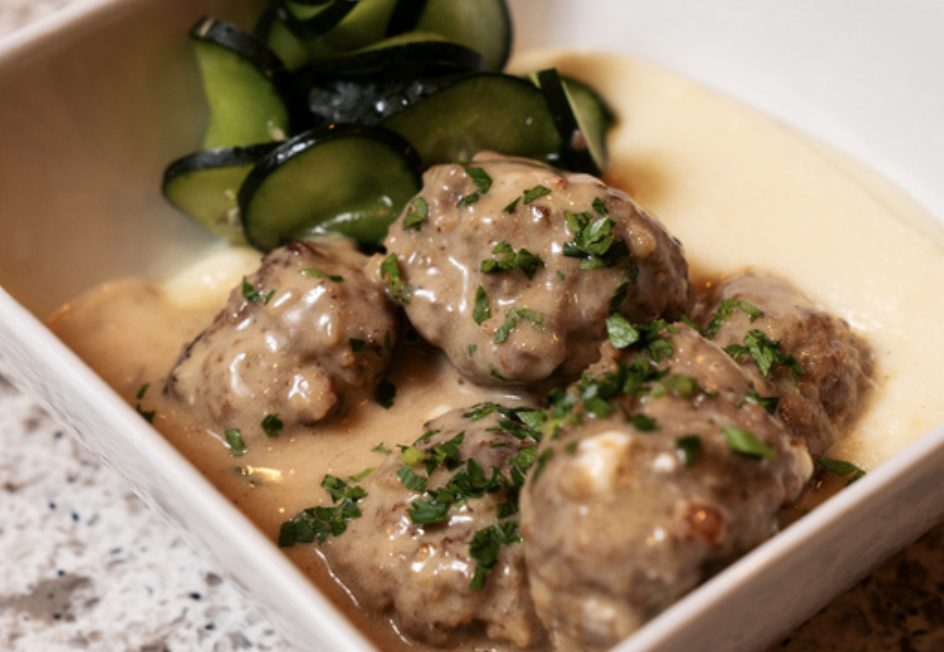Photos by L.G. Patterson
On one of the many snow days we had this winter, my daughter asked to make Swedish meatballs. We found a recipe (she is in charge of reading and gathering the ingredients), and she then said, “I don’t want to add the sour cream sauce.” I told her, “Well, then they will just be meatballs.” We agreed to make the gravy with sour cream and add it to half of the meatballs and she would try some. After trying them, she decided all of the meatballs needed the gravy, and maybe now she liked sour cream. In Sweden, they are called köttbullar, which translates to“meat buns.” It is believed that they were brought back by King Charles XII from Turkey, and they may be derived from Turkish köfte.
Meat
You have a full spectrum of meat that you can use to make the meatballs, just follow the ratio and proper internal cooking temperature. From what I have seen, pork and beef are traditional, but you could substitute lamb or veal, and the proper internal temperature would be 155degrees. Chicken or turkey could also be added, and the proper temperature would need to be 165 degrees.
Panade
The meatballs not holding together while cooking is one of the common problems people run into making any meatballs. But, there is a way to solve this problem.The most common reason they fall apart is the lack of a panade. A panade is typically a mixture of bread, milk andegg in a forcemeat (meatballs, sausage, mousseline and meatloaf are a few types) to help bind and retain moisture.Sometimes cooked rice or cooked potato can be a substitute for bread. Not all force meats have a panade, but typically when a panade is present it creates amore stable product.
Seasoning
Nutmeg and cardamom are the major additions, in addition to salt and pepper. Some recipes may also have the addition of allspice or clove. If possible, grinding the cardamom fresh adds much better flavor. Whether you use a spice grinder, mortar and pestle or the bottom of a sauté pan, you get a nicer floral punch of flavor. Same thing with nutmeg, if you use a microplane, nutmeg grater or zester, your result will be a much fresher tasting spice than if you use pre-ground spices.
Cooking
If you are making a half or single batch of meatballs, a sauté pan is the way to go. You should be able to cook all the meatballs in two or three batches, reserve and then finish in the gravy. If you are making a much larger batch, you might try roasting on a sheet tray in the oven at 350 degrees until the meatballs reach the correct temperature, then finish in the gravy.
Gravy
The gravy is pretty straightforward. Melt the butter, make a blonde roux, then add cold or room temperature stock or broth.The roux and the liquid need to be at opposite temperatures when incorporated to prevent breaking and lumps from forming. You won’t see the full thickness of the roux until the mixture has come to a simmer. It is best if it is a little thin at first because you will need to simmer for five to seven minutes to cook away the flour taste. The meatballs can then be added back in (since they have already been browned, it is OK to crowd them more) once they have heated through.Sour cream can be added, as well as mustard if desired. They can be folded into the sauce, coated on the meatballs, and they are ready to enjoy.
Sides
Traditionally mashed potatoes, buttered noodles, pressed cucumber salad and lingonberry jam can accompany the meatballs on the side. They can also work on their own as an excellent appetizer.One great thing is the meatballs can be made a day or two ahead of time, allowing you more time the day you are serving them to work on your sides and other dishes that are being served.
Swedish Meatballs
Ingredients
MEATBALLS
- 1 pound ground beef
- 1 pound ground pork
- 1 cup breadcrumbs
- 1 egg
- 1 small onion
- 1 teaspoon ground nutmeg
- 1 teaspoon ground cardamom
- 1 teaspoon black pepper
- 1 tablespoon kosher salt
- 1 cup milk
- 1 ounce butter
- 1 ounce oil
GRAVY
- 1 ounce butter
- 1 ounce flour
- 1 pint stock or broth
- 1/2 cup sour cream
- 1 teaspoon Dijon mustard (optional)
- salt and pepper to taste
Instructions
- Mix all ingredients from ground beef to milk together until a solid uniform mixture is formed.
- Take a small piece out, cook it like a miniham burger and taste it. Season more as needed and make a second test patty if needed.
- Form 1-ounce spheres, and cool in the refrigerator for 15 to 20 minutes (up to three or four hours).
- In a large sauté pan, brown small batches of the meatballs in the butter and oil over medium heat, just until browned. They do not need to be fully cooked, reserve to the side
- Clean the sauté pan, then over medium heat, melt butter. Then whisk in flour and cook until fully incorporated but no color has developed.
- Slowly whisk in cool or room temperature stock. Simmer for five to seven minutes until gravy has thickened and the flour taste has cooked away
- Add all the meatballs back into the pan (if the pan will not hold all of the meatballs, cook in batches). Simmer in the gravy, turning the meatballs frequently until cooked all the way through (break one open to make sure all pink is gone).
- Turn off the heat, add the sour cream and slowly fold into the sauce. Take the gravy, season as needed with salt and pepper and serve over mashed potatoes with pressed cucumber salad and lingonberry jam (cranberries can work as a substitute).








